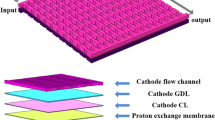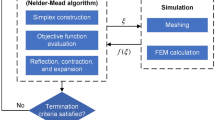Abstract
Solid oxide fuel cells (SOFCs) are a source of renewable and economical energy production. The present study focused on investigating the effect of changing the size of the obstacles on cell performance by placing obstacles into the flow channel and defining the aspect ratio parameter that indicates the height of the obstacle to that of the flow channel. For rectangular obstacles with the values of one, nine-tenths, seven-tenths, and a half of the aspect ratio (AR) parameter at a voltage of 0.8 V, the output power improved by 40, 18, 13.7, and 13.2% compared to the unobstructed flow channel (reference state). At the same voltage, the current density improved by 10, 9.76, and 9.64 for the values of nine-tenths, seven-tenths, and a half of the AR parameter for triangular obstacles, respectively. Further, it improved by 20.2, 19.7, and 19.3% for trapezoidal obstacles compared to the reference model. Therefore, the output power is maximized when the rectangular obstacles completely cover the flow channel.












Similar content being viewed by others
Abbreviations
- F:
-
Faraday’s constant which is about 96, 500 \((c/mol)\)
- F:
-
Volume force (vector) \((N/m^{3} )\)
- \(c_{p}\) :
-
Fluid heat capacity when pressure is constant \((j/kgk)\)
- \(M_{i}\) :
-
Molar mass for species I \((kg/mol)\)
- a, b, m:
-
Exponents
- \(G_{m}\) :
-
The popular Gibbs energy (J/mol)
- \(Q_{a}\) :
-
Current term (source or sink) for anode \((A/m^{2} )\)
- \(R_{i}\) :
-
Rate expression (production, consumption) \((kg/m^{3} .s)\)
- \(S_{m}\) :
-
Entropy change (J/mol. K)
- \(Q_{m}\) :
-
Heat generated by electrochemical reaction \((W/m^{3} )\)
- I :
-
Current density)vector( \(({\text{A}}/{\text{m}}^{2} )\)
- \(E^{O}_{{H_{2} /O_{2} }}\) :
-
Open-circuit voltage when pressure is 1 atm \((V)\)
- \(Q_{br}\) :
-
Mass that would be related to source or sink \((kg/m^{3} .s)\)
- \(d_{ref}\) :
-
Reference diffusivity \((m^{2} /s)\)
- \(Q_{h}\) :
-
Heat that would be related to source or sink \((W/m^{3} )\)
- x,y,z:
-
The popular Cartesian coordinates
- К:
-
Describe permeability tensor for porous medium (\(m^{2}\))
- \(\phi_{ele}\) :
-
Electronic potential (V)
- u:
-
Average velocity of mass (m/s)
- \(E_{A,a}\) :
-
Activation energy (J/mol)
- \(c_{i}\) :
-
Molar concentration \((mol/m^{3} )\)
- A, C, E:
-
Anode, cathode, electrolyte
- eq:
-
Subscript for equilibrium
- \(\phi\) :
-
Electrical potential (V)
- \(\partial\) :
-
Conductivity (effective) (S/m)
- SOFC:
-
Abbreviation for solid oxide fuel cells
- \(\Delta_{eq}\) :
-
Potential difference (equilibrium) (V)
- \((\rho c_{p} )_{eq}\) :
-
Balanced volumetric heat capacity when pressure is constant \((J/m^{3} .k)\)
- \(Q_{c}\) :
-
Current term (source or sink) for cathode -\((A/m^{2} )\)
- T :
-
Temperature (absolute)-(K)
- D:
-
Abbreviation for dimension
- \(\phi_{ion}\) :
-
Ionic potential (V)
- \(H_{m}\) :
-
Reaction enthalpy change (J/mol)
- CFD:
-
Abbreviation for computational fluid dynamics
- \(\mu\) :
-
Viscosity (dynamic) (Pa. s)
- \(Q_{e}\) :
-
Current density term for electrolyte (source or sink) \(({\text{A}}/{\text{m}}^{2} )\)
- \(D^{T}_{i}\) :
-
Thermal diffusion coefficient (kg/m. s)
- \(\nu\) :
-
Describe molecular diffusion volume \(({\text{cm}}^{3} /{\text{mol}})\)
- m:
-
Index m (for describing reaction)
- ele:
-
Subscript for electronic
- \(\eta\) :
-
Describe overpotential (V)
- R:
-
Global gas constant that is 8.31 (J/mol. K)
- \(D_{ik}\) :
-
Multicomponent Maxwell–Stefan diffusivity \(({\text{m}}^{2} /{\text{s}})\)
- \(\gamma\) :
-
Temperature-dependent prefactor
- x:
-
Describe molar fraction
- \(j_{i}\) :
-
Mass flux related to average velocity of mass \(({\text{kg}}/{\text{m}}^{2} .s)\)
- \(V_{cell}\) :
-
Voltage of cell (V)
- OCV:
-
Abbreviation for open-circuit voltage
- \(c_{i,ref}\) :
-
Reference molar concentration \(({\text{mol}}/{\text{m}}^{3} )\)
- \(Q_{JH}\) :
-
Ohmic heating \(({\text{W}}/{\text{m}}^{3} )\)
- G:
-
Abbreviation for generation
- \(k_{eq}\) :
-
Thermal conductivity (equivalent) (W/m. K)
- \(\omega_{i}\) :
-
Mass fraction (for species i)
- I:
-
The popular unit matrix
- ion:
-
Subscript for ionic
- \(p_{i}\) :
-
Partial pressure related to species i at TPB region (Pa)
- \(\varepsilon\) :
-
Porosity
- I, J, K:
-
Species I, j, k
- P:
-
Pressure (Pa)
- \(\rho\) :
-
Density \(({\text{kg}}/{\text{m}}^{3} )\)
References
Ferguson, J.R.; Fiard, J.M.; Herbin, R.: Three-dimensional numerical simulation for various geometries of solid oxide fuel cells. J Power Sources 58(2), 109–122 (1996)
Khazaee, I.; Rava, A.: Numerical simulation of the performance of solid oxide fuel cell with different flow channel geometries. Energy 119, 235–244 (2017). https://doi.org/10.1016/j.energy.2016.12.074
Zeng, X.; Ge, Y.; Shen, J.; Zeng, L.; Liu, Z.; Liu, W.: The optimization of channels for a proton exchange membrane fuel cell applying genetic algorithm. Int. J. Heat Mass Transfer 105, 81–89 (2017)
Saied, M.; Ahmed, K.; Nemat-Alla, M.; Ahmed, M.; El-Sebaie, M.: Performance study of solid oxide fuel cell with various flow field designs: numerical study. Int. J. Hydrogen Energy. 43, 20931–20946 (2018). https://doi.org/10.1016/j.ijhydene.2018.09.034
Heidary, H.; Kermani, M.J.; Dabir, B.: Influences of bipolar plate channel blockages on PEM fuel cell performances. Energy Convers Manag 124, 51–60 (2016)
Ebrahimzadeh, A.A.; Khazaee, I.; Fasihfar, A.: Heliyon numerical investigation of obstacle ’ s effect on the performance of proton-exchange membrane fuel cell : studying the shape of obstacles. Heliyon. 5, e01764 (2019). https://doi.org/10.1016/j.heliyon.2019.e01764
Ghanbarian, A.; Kermani, M.J.: Enhancement of PEM fuel cell performance by flow channel indentation. Energy Convers manag 110, 356–366 (2016)
Perng, S.; Wu, H.; Chen, Y.; Zeng, Y.: Performance enhancement of a high temperature proton exchange membrane fuel cell by bottomed-ba ffl es in bipolar-plate channels. Appl. Energy. 255, 113815 (2019). https://doi.org/10.1016/j.apenergy.2019.113815
Khazaee, I.: Effect of placing different obstacles in flow fields on performance of a PEM fuel cell: Numerical investigation and experimental comparison. Heat Mass Transf. Und Stoffuebertragung. 49, 1287–1298 (2013). https://doi.org/10.1007/s00231-013-1166-3
Ku, H.; Wu, H.: In fluences of operational factors on proton exchange membrane fuel cell performance with modified interdigitated flow field design. J. Power Sources 232, 199–208 (2013). https://doi.org/10.1016/j.jpowsour.2013.01.020
Ranjbar, A.A.; Ramiar, A.; Alizadeh, E.; Aghaee, M.: ScienceDirect Improving PEM fuel cell performance and effective water removal by using a novel gas flow field. Int. J. Hydrogen Energy. 41, 1–15 (2015). https://doi.org/10.1016/j.ijhydene.2015.11.001
Manglik, R.M.; Magar, Y.N.: Heat and mass transfer in planar anode-supported solid oxide fuel cells: effects of interconnect fuel/oxidant channel flow cross. Section 7, 1–10 (2015). https://doi.org/10.1115/1.4030636
Duhn, J.D.; Jensen, A.D.; Wedel, S.; Wix, C.: Optimization of a new flow design for solid oxide cells using computational fluid dynamics modelling. J. Power Sources. 336, 261–271 (2016). https://doi.org/10.1016/j.jpowsour.2016.10.060
Celik, A.N.: ScienceDirect Three-dimensional multiphysics model of a planar solid oxide fuel cell using computational fluid dynamics approach *. Int. J. Hydrogen Energy. 43, 1–19 (2018). https://doi.org/10.1016/j.ijhydene.2018.08.212
Andersson, M.; Paradis, H.; Yuan, J.; Sunden, B.: Three dimensional modeling of an solid oxide fuel cell coupling charge transfer phenomena with transport processes and heat generation. Electrochim. Acta. 109, 881–893 (2013). https://doi.org/10.1016/j.electacta.2013.08.018
Zitouni, B.; Andreadis, G.M.; Hocine, B.M.; Hafsia, A.; Djamel, H.; Mostefa, Z.: Two-dimensional numerical study of temperature field in an anode supported planar SOFC: Effect of the chemical reaction. Int. J. Hydrogen Energy. 36, 4228–4235 (2011). https://doi.org/10.1016/j.ijhydene.2010.07.141
Shi, J.; Xue, X.: CFD analysis of a symmetrical planar SOFC with heterogeneous electrode properties. Electrochim. Acta. 55, 5263–5273 (2010). https://doi.org/10.1016/j.electacta.2010.04.060
Akhtar, N.; Decent, S.P.; Loghin, D.; Kendall, K.: A three-dimensional numerical model of a single-chamber solid oxide fuel cell. Int. J. Hydrogen Energy. 34, 8645–8663 (2009). https://doi.org/10.1016/j.ijhydene.2009.07.113
Njodzefon, J.-C.; Klotz, D.; Kromp, A.; Weber, A.; Ivers-Tiffée, E.: Electrochemical Modeling of the Current-Voltage Characteristics of an SOFC in Fuel Cell and Electrolyzer Operation Modes. J. Electrochem. Soc. 160, F313–F323 (2013). https://doi.org/10.1149/2.018304jes
Andersson, M.; Yuan, J.; Sundén, B.: SOFC modeling considering electrochemical reactions at the active three phase boundaries. Int. J. Heat Mass Transf. 55, 773–788 (2012). https://doi.org/10.1016/j.ijheatmasstransfer.2011.10.032
Digiuseppe, G.; Gowda, Y.J.; Honnagondanahalli, N.K.: A two-dimensional modeling study of a planar SOFC using actual cell testing geometry and operating conditions. J. Fuel Cell Sci. Technol. 9, 1–12 (2012). https://doi.org/10.1115/1.4005124
Kuo, J.K.; Wang, J.K.: Characteristic simulation with various anode support thicknesses of membrane electrode assembly in SOFC. J. Solid State Electrochem. 16, 329–340 (2012). https://doi.org/10.1007/s10008-011-1328-5
Liu, S.; Kong, W.; Lin, Z.: Three-dimensional modeling of planar solid oxide fuel cells and the rib design optimization. J. Power Sources 194, 854–863 (2009). https://doi.org/10.1016/j.jpowsour.2009.06.056
Amiri, S.; Hayes, R.E.; Nandakumar, K.; Sarkar, P.: Mathematical modeling of a novel tubular micro-solid oxide fuel cell and experimental validation. Chem. Eng. Sci. 65, 6001–6013 (2010). https://doi.org/10.1016/j.ces.2010.08.029
Andersson, M.; Yuan, J.; Sundén, B.: SOFC cell design optimization using the finite element method based CFD approach. Fuel Cells. 14, 177–188 (2014). https://doi.org/10.1002/fuce.201300160
Dokmaingam, P.; Irvine, J.T.S.; Assabumrungrat, S.; Charojrochkul, S.; Laosiripojana, N.: Modeling of IT-SOFC with indirect internal reforming operation fueled by methane: Effect of oxygen adding as autothermal reforming. Int. J. Hydrogen Energy. 35, 13271–13279 (2010). https://doi.org/10.1016/j.ijhydene.2010.09.045
Leonide, A.; Apel, Y.; Ivers-Tiffee, E.: SOFC modeling and parameter identification by means of impedance spensert ctroscopy. ECS Trans. 19, 81–109 (2019). https://doi.org/10.1149/1.3247567
Shi, J.; Xue, X.: CFD analysis of a novel symmetrical planar SOFC design with micro-flow channels. Chem. Eng. J. 163, 119–125 (2010). https://doi.org/10.1016/j.cej.2010.07.031
Repetto, L.; Costamagna, P.: FEM model of the ohmic resistance of IP-SOFCs. J. Appl. Electrochem. 38, 1005–1010 (2008). https://doi.org/10.1007/s10800-008-9526-2
Author information
Authors and Affiliations
Corresponding author
Ethics declarations
Conflict of interests
The authors declare that they have no known competing financial interests or personal relationships that could have appeared to influence the work reported in this paper.
Rights and permissions
Springer Nature or its licensor holds exclusive rights to this article under a publishing agreement with the author(s) or other rightsholder(s); author self-archiving of the accepted manuscript version of this article is solely governed by the terms of such publishing agreement and applicable law.
About this article
Cite this article
Choroomzadeh, M., Khazaee, I. Significance of Aspect Ratio Parameter on a Solid Oxide Fuel Cell with Rectangular, Trapezoidal, and Triangular Obstacles in the Flow Channel. Arab J Sci Eng 48, 8595–8611 (2023). https://doi.org/10.1007/s13369-022-07226-1
Received:
Accepted:
Published:
Issue Date:
DOI: https://doi.org/10.1007/s13369-022-07226-1





